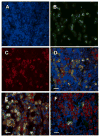Regulation and distribution of squirrel monkey chorionic gonadotropin and secretogranin II in the pituitary
- PMID: 21095191
- PMCID: PMC3022110
- DOI: 10.1016/j.ygcen.2010.11.010
Regulation and distribution of squirrel monkey chorionic gonadotropin and secretogranin II in the pituitary
Abstract
Secretogranin II (SgII) is a member of the granin family of proteins found in neuroendocrine and endocrine cells. The expression and storage of SgII in the pituitary gland of Old World primates and rodents have been linked with those of luteinizing hormone (LH). However, New World primates including squirrel monkeys do not express LH in the pituitary gland, but rather CG is expressed. If CG takes on the luteotropic role of LH in New World primates, SgII may be associated with the expression and storage of CG in the pituitary gland. The goal of this study was to evaluate the regulation and distribution of CG and SgII in the squirrel monkey. A DNA fragment containing approximately 750 bp of squirrel monkey SgII promoter was isolated from genomic DNA and found to contain a cyclic-AMP response element that is also present in the human SgII promoter and important for GnRH responsiveness. The squirrel monkey and human SgII promoters were similarly activated by GnRH in luciferase reporter gene assays in LβT2 cells. Double immunofluorescence microscopy demonstrated close association of SgII and CG in gonadotrophs of squirrel monkey pituitary gland. These results suggest that CG and SgII have a similar intercellular distribution and are coregulated in squirrel monkey pituitary gland.
Copyright © 2010 Elsevier Inc. All rights reserved.
Figures



Similar articles
-
Tissue-specific expression of squirrel monkey chorionic gonadotropin.Gen Comp Endocrinol. 2011 Feb 1;170(3):514-21. doi: 10.1016/j.ygcen.2010.11.023. Epub 2010 Dec 2. Gen Comp Endocrinol. 2011. PMID: 21130091 Free PMC article.
-
Regulation of expression of secretogranin II mRNA in female rat pituitary and hypothalamus.Neuroendocrinology. 1993 Mar;57(3):422-31. doi: 10.1159/000126388. Neuroendocrinology. 1993. PMID: 8321414
-
Molecular cloning of pituitary glycoprotein alpha-subunit and follicle stimulating hormone and chorionic gonadotropin beta-subunits from New World squirrel monkey and owl monkey.Gen Comp Endocrinol. 2008 Feb 1;155(3):534-41. doi: 10.1016/j.ygcen.2007.08.004. Epub 2007 Aug 24. Gen Comp Endocrinol. 2008. PMID: 17897645 Free PMC article.
-
Secretoneurin as a hormone regulator in the pituitary.Regul Pept. 2010 Nov 30;165(1):117-22. doi: 10.1016/j.regpep.2009.11.019. Epub 2009 Dec 16. Regul Pept. 2010. PMID: 20006654 Review.
-
The differential secretion of FSH and LH: regulation through genes, feedback and packaging.Reprod Suppl. 2003;61:463-76. Reprod Suppl. 2003. PMID: 14635955 Review.
Cited by
-
Tissue-specific expression of squirrel monkey chorionic gonadotropin.Gen Comp Endocrinol. 2011 Feb 1;170(3):514-21. doi: 10.1016/j.ygcen.2010.11.023. Epub 2010 Dec 2. Gen Comp Endocrinol. 2011. PMID: 21130091 Free PMC article.
References
-
- Alarid ET, Windle JJ, Whyte DB, Mellon PL. Immortalization of pituitary cells at discrete stages of development by directed oncogenesis in transgenic mice. Development. 1996;122:3319–3329. - PubMed
-
- Bassetti M, Huttner WB, Zanini A, Rosa P. Co-localization of secretogranins/chromogranins with thyrotropin and luteinizing hormone in secretory granules of cow anterior pituitary. J Histochem Cytochem. 1990;38:1353–1363. - PubMed
-
- Cibelli G, Jungling S, Schoch S, Gerdes HH, Thiel G. Identification of a functional cAMP response element in the secretogranin II gene. Eur J Biochem. 1996;236:171–179. - PubMed
-
- Clarke IJ, Cummins JT. The temporal relationship between gonadotropin releasing hormone (GnRH) and luteinizing hormone (LH) secretion in ovariectomized ewes. Endocrinology. 1982;111:1737–1739. - PubMed
-
- Conn PM, Janovick JA, Braden TD, Maurer RA, Jennes L. SIIp: a unique secretogranin/chromogranin of the pituitary released in response to gonadotropin-releasing hormone. Endocrinology. 1992;130:3033–3040. - PubMed
Publication types
MeSH terms
Substances
Grants and funding
LinkOut - more resources
Full Text Sources

